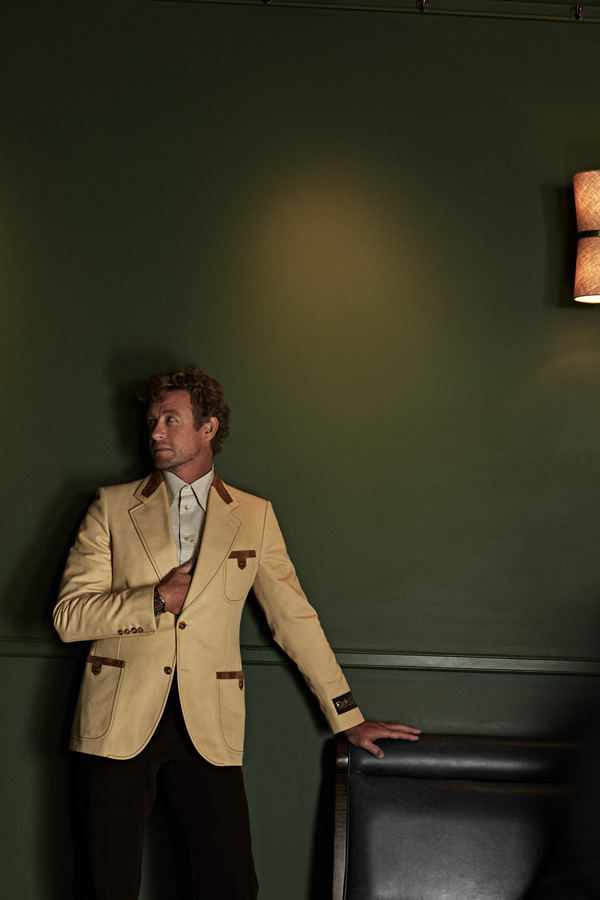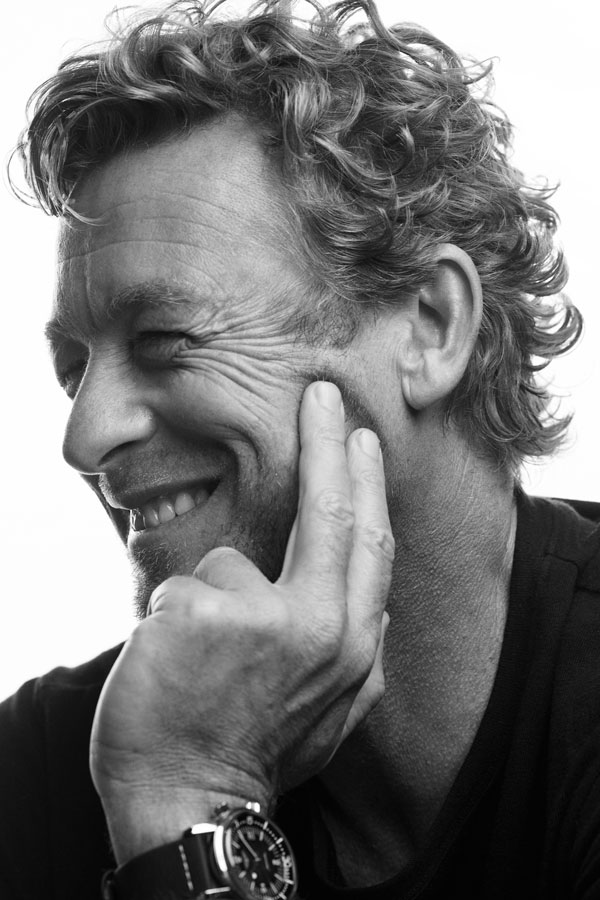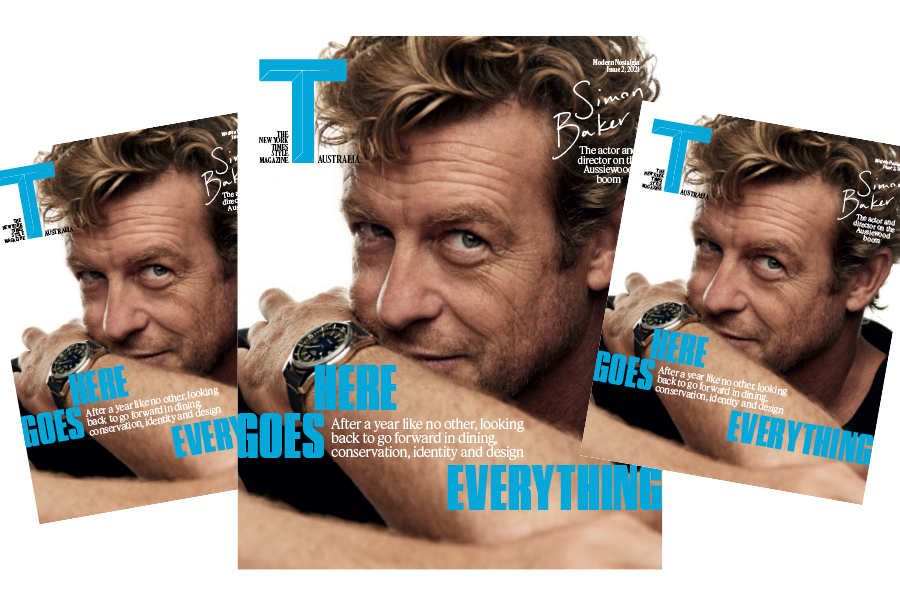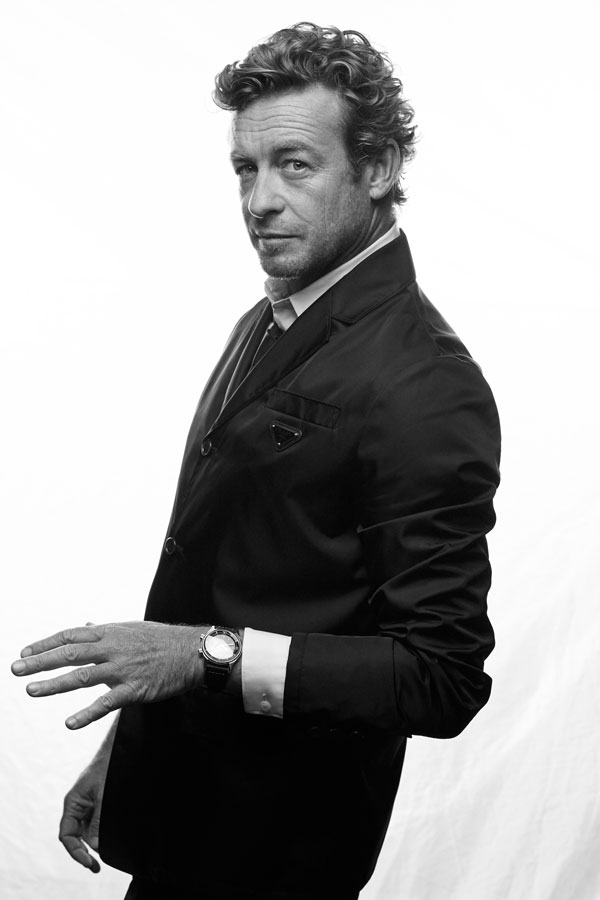Today, he’s internationally famous, best known as the star of the long-running TV series “The Mentalist”. But in the early 1990s, when Simon Baker was in his 20s, he was a sturdy regular on Australian soap operas, notably “E Street” and “Home and Away”. Wanting more, he auditioned for a role in what was to become a major Australian film, “Muriel’s Wedding”. He did not get the part — and yet he was still in the movie.
In Australia at the time, a TV actor was hardly considered an actor at all. “Film actors would drive a taxi when they were not working,” Baker says. “But they would not deign to do TV.” In turn, those who did do TV were regarded with disdain by their big brothers and sisters in the film world. Perhaps because of that hardly sporting bias, Baker was not chosen for the film. But here’s where the complex social dynamic of the time comes into play. Written and directed by a young PJ Hogan, whose gimlet eye makes for a darkly comic yet refreshingly relatable tale, it’s the story of a young woman from a somewhat grimy background on the North Coast of New South Wales who travels to Sydney to realise her long-standing dream: to find herself a husband. She leaves behind a dreadful family, including a dishevelled, barely sentient sister, Joanie, who symbolises all that ensnares Muriel and, conveniently, serves as a metaphor for our story right here.
On the walls of Joanie’s room are photos of her own fantasies; among them, if you look closely, a pin-up of a handsome young Australian TV actor known for his work in popular soap operas — one Simon Baker. Muriel’s sister knew talent when she saw it. The city and the suburbs. Australia and the world. Film and TV. Art and trash. A brilliant young filmmaker and an ambitious young actor. Mass appeal and the desires of the self-made artist. All of these dualities are at play in that one fleeting second of screen time, and they remain today, mutatis mutandis, in an industry that struggles to give local artists a voice, even as big- budget productions from around the world flock to our shores.

Nearly 30 years on, Baker has turned his dream into two decades of stardom and the sort of wealth one accrues from starring in two successful US TV series (in 2010, Baker extended his “The Mentalist” contract in a deal reported to be worth $US30 million [$AU38.8 million]). It helps, of course, that his is the sort of camera-ready face that invites endorsement deals from major brands, including Givenchy and ANZ. For almost a decade, he’s also been an Ambassador of Elegance for Longines, joining the likes of Kate Winslet and tennis stars Andre Agassi and Steffi Graf.
All the while, he has maintained his connection to Australia, returning to direct his first film, 2017’s “Breath”, a coming-of- age surf story adapted from the classic Tim Winton novel of the same name. Having moved back to Australia in 2015, Baker is a local among the many Hollywood stars who’ve descended on Australia in a wave of post-pandemic filmmaking, including Julia Roberts, Viggo Mortensen and Colin Farrell.
He’s working on an Australian project: “Blaze”, the first feature film by the Archibald-winning artist Del Kathryn Barton. “She approached me and we talked about the project and really got on really well. I liked her intentions with the film,” Baker says. “The intention is a curious way I approach work. I have to see the director’s intention. There’s entertainment — there’s Marvel movies, which are entertaining. I like to see an intention, whether that is to disregard certain aspects of society or to shine a light on certain aspects of society. That is the focus for me.”
A local production with a modest budget, “Blaze” is the sort of film that could not be made without government funding or the help of marquee names such as Baker’s. And while the flood of international movies currently filming in Australia is a phenomenon that’s good for almost everyone involved, it has made it even more difficult for local productions like “Blaze” to get off the ground.
Baker, who freely admits he’s a worrier, is concerned about the impact Hollywood will have on the local industry, as are others in the community. “We have a finite number of crew members in Australia,” he says. “There’s a lot of scaling up in opportunity in the film business right now, for local craftsmen and craftswomen and technicians, which is great. But is it at the expense of local content?”

Despite Australia’a good reputation as a filming locale and the many productions made here, those in the business of attracting foreign film crews have struggled in the past, thanks to outdated government incentives. Simply put, landing a Hollywood film depends on coming up with creative ways to subsidise it. It’s a tough system: countries are in competition over productions, allowing the major studios to drive hard bargains and pit nations (and, in America, states) against one another.
It’s a game that must be played and, at a certain point, it was apparent Australia wasn’t playing it well. “Our tax offset program was not competitive globally,” says Kate Marks, the chief executive of Ausfilm, which assists foreign productions with sourcing Australian talent, infrastructure and funding. “We were at 16.5 per cent, versus 20–25 per cent elsewhere. Ours was one of the lowest.” In 2018, the Federal Government introduced a Location Incentive grant that could be combined with the 16.5 per cent tax offset, available to foreign films that spent $15 million or more on Australian production. Grants totalling $140 million were scooped up by new productions and the industry advocated for more.
Then the pandemic hit. Australia’s relatively competent handling of the coronavirus presented an opportunity for the industry: the country was open for business while other locations were not — including the American states outside of California that are generally favoured by Hollywood, but whose response to the pandemic has been disastrous. Meanwhile, the boom in streaming services had produced a seemingly endless need for content, particularly bingeable TV series. Despite the strict Covid-19 safety protocols for workers and the two-week quarantine period for international arrivals, Australia was in a unique position.
But Hollywood being Hollywood, government incentives were still an issue. Ausfilm made the case that film production could play a role in the country’s economic recovery. “In part, it’s the nature of how productions work,” Marks says. “They can ramp up quickly and get so many people back to work faster than most industries.” In mid-2020, another $400 million was allocated to Location Incentive grants, available until June 2027.

So far, the plan seems to be working. According to Marks, the average value of production expenditure from foreign films in Australia has been, over the last five years, $350 million annually; this year, Ausfilm expects the figure will be double that. International films and TV series that have been recently completed, are currently filming or are slated to start in the coming months, include: “Thirteen Lives”, directed by Ron Howard, starring Viggo Mortensen and Colin Farrell; “Joe Exotic”, about the Exotic/Carole Baskin feud made famous by the Netflix documentary series “Tiger King”; “Pieces of Her”, starring Toni Collette; “Young Rock”, based on the early life of Dwayne “The Rock” Johnson; and “Ticket to Paradise”, starring Julia Roberts and George Clooney. Tom Hanks has also been in Australia, for a Baz Luhrmann film about Elvis Presley, but the production is a local one (it became worldwide news when Hanks and his wife, Rita Wilson, tested positive for coronavirus while in Australia early last year).
These, of course, join the much- noted blockbusters made in Australia of late, including the recently released “Godzilla vs. Kong” and the soon-to- wrap “Thor: Love and Thunder”, starring Chris Hemsworth. These films fill studios, employ builders, technicians and supporting actors, and provide steady contracts for visual-effects houses, but they also present challenges for local players.
“These big productions, they’re a little gung-ho,” says Ivan Sen, a writer and director whose credits include “Toomelah” and “Mystery Road”. By way of example, he says a supermarket might say no to a local filmmaker in search of a location, having hosted a major production that took too long or destroyed the place. “We’re sensitive to that, to our locations and who we are,” Sen says, adding that a major studio might pay $10,000 for the use of the location. “They look at our measly $500 and tell us to get lost.”
Even booking a studio can be difficult. For his upcoming film, “Loveland”, Sen says, “We tried to find one on the Gold Coast but just had no chance. Speaking of ‘Godzilla’, that’s what it was! We ended up at a TAFE studio in Queensland.”

Baker might be accustomed to “Godzilla”-size productions now, but the Hollywood life was not preordained. Born in Tasmania, he spent a few years in New Guinea before his parents split up and he moved with his mother to Lennox Head on New South Wales’ North Coast (he has hinted that his relationship with her second husband was not ideal). Baker was immersed in surf culture and was infatuated with film. “I was raised on ’70s Australia cinema,” he says, citing the directors Fred Schepisi, Peter Weir and Gillian Armstrong. “It was a golden age and I grew up seeing all of that.”
He came to acting by happenstance, his big break like something out of a movie. It came when he visited a friend who was auditioning for a commercial — Baker ended up getting the role. At the age of 22, he was cast in “E Street”, then came a Logie Award for Most Popular New Talent and “Home and Away”. Still, film roles were a long time coming — he could not break out of the TV ghetto. “I was auditioning and auditioning for ‘traffic cop number two’ and it was really difficult,” he says. “I came up with a long- range idea: what about going to America and trying to make it there? If I can get some work in the US, maybe I can come back to Australia and work here. It took me 20-something years.”
In the US, Baker landed a small role, playing a vulnerable young actor in 1997’s “L.A. Confidential” (a film that might have won the Academy Award for Best Picture had the blockbuster “Titanic” not been released in the same year). Baker had one memorable line — “You know, when I came out to LA, this isn’t exactly where I saw myself ending up” — before being fed into Hollywood’s thresher.

Steady work but minor roles followed until he was cast in the TV series “The Guardian”. Starting in 2001, it ran for three seasons but didn’t make much of a cultural mark. Exhausted by television, Baker returned to film, with roles in “The Ring Two” and “The Devil Wears Prada” (he even shot a commercial with Martin Scorsese). He also starred in a project that was fairly unusual at the time, 2006’s “Something New”, an interracial romance directed by Sanaa Hamri, the rarest of things in Hollywood — a woman of colour in the director’s seat. It went nowhere. “Everything around that film would be different if it was released now,” Baker says.
Then came the role that made him an international celebrity: the lead in a police drama called “The Mentalist”. The show is a little smarter than the title indicates. In it, Baker plays a consultant for the California Bureau of Investigation who once passed himself off as a psychic and now uses the insights of a conman to solve crimes (of course, as is the way with these things, he doesn’t always play by the rules and exasperates his superiors). The unnaturally handsome Baker has a way with quips and he plays the unnaturally insightful investigator with winning charm. For his work on the series, he has been nominated for one Emmy and two Golden Globe awards.
Acting aside, Baker plays the role of TV star with aplomb. A YouTube clip shows him doing a good job of acting surprised when the host of “The Tonight Show Starring Jimmy Fallon” mentions the actor’s Mick Jagger impression, prompting an impression showdown. But there have been challenges along the way, too, like the separation, in 2020, from his wife of 23 years, the actress Rebecca Rigg, whom he met on the set of “E Street”. The pair raised three children in a house in Santa Monica, LA, that they’ve since sold for more than $8 million.
In this time of extraordinary change, Baker is looking forward to pursuing passion projects. “For the large portion of my career, I’m a father of three and I’ve been a provider more than anything — and been an artist as a secondary thing,” he says. “Now my kids are older and I’m older, clearly. And I look more now for what resonates in a story, what I can feel as far as intention from the director, and then I go from there.”
Since “The Mentalist” ended in 2015, Baker has concentrated on Australian films. First up was “Breath”, which he not only directed, but also co-wrote, produced and starred in, playing the enigmatic surfer Sando, who transforms the lives of two boys on the cusp of adulthood. Baker, who directed a few episodes of “The Mentalist” over the years, handles the film’s complex psychological undercurrents seamlessly, as well as the technical demands of the water scenes.
It was the realisation of a long-held dream. “I thought, ‘I’ll come back to Australia and I’ll make this film, that will be for me. This will be my contribution to a profession I really love and Australian cinema, which I grew up watching.’ ” He also starred in “High Ground” (2020), a true story, set in the Northern Territory, about a massacre of Aboriginal people in 1919. Baker plays a former police officer who is forced to come to terms with his role years later. The film is by Maxo Studios, Savage Films and Bunya Productions (the latter being the company through which Sen and the director Warwick Thornton have made some of the best films to come out of Australia in recent years).
Those sort of productions, like ‘Breath’ and other films of that quality, are hard to finance, very hard to get up,” says the film critic David Stratton, who has watched the fortunes of Australian film rise and fall over four decades. “There’s a constant challenge to get that sort of film made.” But like many, Baker believes Australia has important stories to share — beyond blonde hair, surfing and suntans. “You see Nicole or Cate,” he says, nodding to those fixtures of the silver screen Nicole Kidman and Cate Blanchett. “But we also have this incredible culture that existed here long before all the blondies arrived. It’s the oldest continuous culture on the planet. Our indigenous people have an incredible history and incredible stories to tell.”
He’s looking forward to seeing the film adaptation of “The Drover’s Wife”, to be released later this year. Based on Henry Lawson’s short story of the same name, the film was written and directed by the “Wentworth” star Leah Purcell, a Goa-Gunggari-Wakka Wakka Murri woman, who originally staged it as a play. “I’m interested to see what she’s going to do with that,” Baker says. “I enjoyed the play. It lends itself to a classic Australian cinematic experience, with a really good twist in the story.”
Baker acknowledges that the local industry will always have its struggles. “It’s not an affordable medium. You are always, always, juggling between the fiscal investment and the culture and art — and the development of a cultural view of society. It’s always going to be a battle with itself.” But after three decades in the profession, working in film and TV, on both sides of the camera and both sides of a large ocean, Baker says: “I love that battle.”
Photography by Jake Terrey. Styling by Brad Homes.
Hair by Renya Xydis at Saunders & Co. Makeup by Liz Kelsh at 22.




 Prada blazer, $4,400, sweater, $1,370, pants, $1,710, and shoes, $1,650; and Longines watch, $3,750. Photography by Jake Terrey. Styling by Brad Homes.
Prada blazer, $4,400, sweater, $1,370, pants, $1,710, and shoes, $1,650; and Longines watch, $3,750. Photography by Jake Terrey. Styling by Brad Homes.